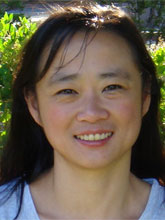Professor Jennifer N. Cha
The PhysOrg article Nanoscience goes ‘big’: Discovery could lead to enhanced electronics said
“Nanoscience has the potential to play an enormous role in enhancing a range of products, including sensors, photovoltaics, and consumer electronics. Scientists in this field have created a multitude of nano scale materials, such as metal nanocrystals, carbon nanotubes, and semiconducting nanowires. However, despite their appeal, it has remained an astounding challenge to engineer the orientation and placement of these materials into the desired device architectures that are reproducible in high yields and at low costs — until now.Jen Cha, a UC San Diego nanoengineering professor, and her team of researchers, have discovered that one way to bridge this gap is to use biomolecules, such as DNA and proteins. Details of this discovery were recently published in a paper titled ‘Large Area Spatially Ordered Arrays of Gold Nanoparticles Directed by Lithographically Confined DNA Origami,’ in Nature Nanotechnology.”
Jennifer N. Cha, Ph.D. is Professor of NanoEngineering, UC San Diego.
Jen’s research is focused on using biological and chemical approaches to assemble nanoscale materials, such as metal and semiconductor nanoparticles, nanorods, nanowires, and single walled carbon nanotubes. Due to their unique electronic, optical, and mechanical properties, nanoscale materials have been heavily explored for applications that range from medicine to electronics to energy. However, their sub-20nm dimensions have led to difficulties in directing their placement, orientation, or assembly into functional architectures.
For example, a bottom-up approach that can direct the placement of nanoscale materials on lithographically defined surfaces is key to many electronics applications. For medical imaging and therapy, it is important to engineer ways to fabricate 3-dimensional biocompatible nanoscale assemblies, such as micelles or liposomes that can also release payloads.
Fundamental research in her laboratory is focused on the design and use of chemistry and engineering to synthesize and create well-defined organic-inorganic systems from nanoscale material building blocks. Because biological molecules, such as peptides, DNA, and proteins, provide significant capabilities for the assembly of nanoscale materials, a significant portion of the research centers around interfacing biological systems with nanoscale objects and using biomolecular interactions to drive the assembly. Specific applications include engineering nanoparticle-peptide systems for in vitro and in vivo detection, synthesizing inorganic-polypeptide systems into 2– and 3-dimensional arrays, and using DNA based bottom-up approaches to build parallel arrays of nanoelectronic devices.
Jen coauthored Silicatein filaments and subunits from a marine sponge direct the polymerization of silica and silicones in vitro, Biomimetic synthesis of ordered silica structures mediated by block copolypeptides, Assembly of Nanoparticles into Hollow Spheres Using Block Copolypeptides, Efficient Catalysis of Polysiloxane Synthesis by Silicatein Α Requires Specific Hydroxy and Imidazole Functionalities, Spontaneous formation of Nanoparticle vesicles from homopolymer polyelectrolytes, and Oriented Mesoporous Organosilicate Thin Films.
Jen earned her B.A. in Cell Biology at UC Berkeley in 1994 and her Ph.D. in Chemistry at UC Santa Barbara in 2001.
